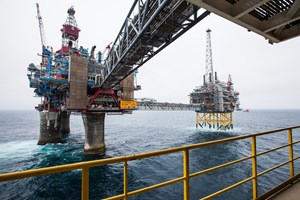Aker BP invests over $20 billion on Norwegian shelf field development plans
(WO) — Aker BP and its partners are submitting a total of ten PDOs (plans for development and operation) and one plan for installation and operation (PIO) to the Ministry of Petroleum and Energy (MPE) on Dec. 16.
With total investments of more than NOK 200 billion ($20.21 billion) in real terms, these Aker BP-operated oil and gas projects represent one of Europe's largest private industrial developments.
Uniquely positioned
Total recoverable resources in these development projects amount to 730 million net barrels of oil equivalent for Aker BP. The projects will also contribute to extending the life of existing production and enable future growth opportunities.
Along with several measures to increase efficiency and recovery, these development projects will enable Aker BP's oil and gas production to grow from around 400,000bpd in 2022 to around 525,000bbl in 2028.
Industry leader in low emissions
Aker BP's CO2 emissions per barrel are among the lowest in the entire oil and gas industry. The emission intensity will be further reduced when these new projects, which will predominantly receive power from shore, come onstream. This is an important element in the company's strategy to achieve net zero emissions by 2030.
"We have a three-pronged strategy to meet the world's growing need for energy while simultaneously contributing to reduce emissions. We will deliver oil and gas with a minimum climate footprint. We will generate revenue that can be used to facilitate the energy transition. And we will contribute knowledge, data and experience to support new industries,” says Hersvik.
Creates jobs, builds expertise
Aker BP's operated development projects are expected to contribute to more than 150,000 full-time equivalents in Norway in supplier companies across the country.
In addition to ensuring activity and jobs, the projects contribute to developing technological expertise in the Norwegian industry in the period before renewable projects are expected to increase in scale.
Development project areas
Yggdrasil (formerly NOAKA)
This is the next large field development on the Norwegian shelf between Alvheim and Oseberg in the North Sea. It contains several discoveries with total recoverable resources of around 650 MMbopd.
The development concept consists of an unmanned production platform to the north (Munin, formerly Krafla), a process platform with a well bay area and living quarters (Hugin A, formerly NOA) to the south and a normally unmanned wellhead platform on Frøy (Hugin B) which will be tied back to Hugin A.
Yggdrasil represents a comprehensive subsea development with a total of nine subsea templates. The plan calls for 55 wells in the area, which will be developed using power from shore.
Until now, Equinor has been the operator for Krafla. Upon submission of the plan for development and operation, the field name is changed to Munin. Aker BP will take over as operator and will hence be the operator for the entire area in both the development and operations phases.
The total investments are estimated at NOK 115 billion ($11.62 billion). Recoverable resources are estimated at 650 MMbopd with a production start date planned in 2027. The license partners are Aker BP, Equinor and LOTOS.
Valhall PWP – Fenris (formerly King Lear)
This unitized development includes a new process and wellhead platform (PWP) bridge connected to the Valhall field center. An unmanned wellhead platform on Fenris that will produce through a 50 km pipeline to Valhall PWP. Valhall PWP will have an essential role in the further development of the Valhall area.
Gas production from Fenris will make a significant contribution to long-term and predictable gas supplies to Europe.
The total investments are estimated at NOK 50 billion ($5.05 billion). Reserves are estimated at 230 MMbopd with a production start date planned in 2027. The license partners are Aker BP, PGNiG Upstream Norway and Pandion Energy.
Three developments in the Skarv area (Skarv satellite project)
These developments include the Alve Nord, Idun Nord and Ørn gas and condensate discoveries in the northern part of the Norwegian Sea. The fields will be developed using subsea solutions connected to the production vessel on the Skarv field (Skarv FPSO).
The developments will be carried out as a joint project – the Skarv satellite project (SSP). These developments will contribute to continued high production and an extended lifetime for Skarv FPSO.
The total investments are estimated at NOK 12 billion ($1.21 billion). With a plan to start production in 2027, the recoverable resources are estimated at 120 MMbopd. The license partners are Aker BP, Equinor, PGNiG Upstream Norway and Wintershall DEA.
Utsira High
Three satellite projects will utilize the capacity of Edvard Grieg and Ivar Aasen on the Utsira High in the North Sea. New names will be used for license groups and facilities. Symra (formerly Lille Prinsen) will be a tie-in to Ivar Aasen while Solveig Phase 2 and Troldhaugen (formerly Rolvsnes) will be tied into the Edvard Grieg platform.
For Solveig Phase 2, a report will be submitted to the MPE, rather than a separate PDO.
The total investments are estimated at NOK 21 billion ($2.12 billion). Aker BP, Sval Energi, OMV and Wintershall DEA are the license partners. Production is planned to start in 2026 or 2027 with recoverable resources estimated at 124 MMbopd.



